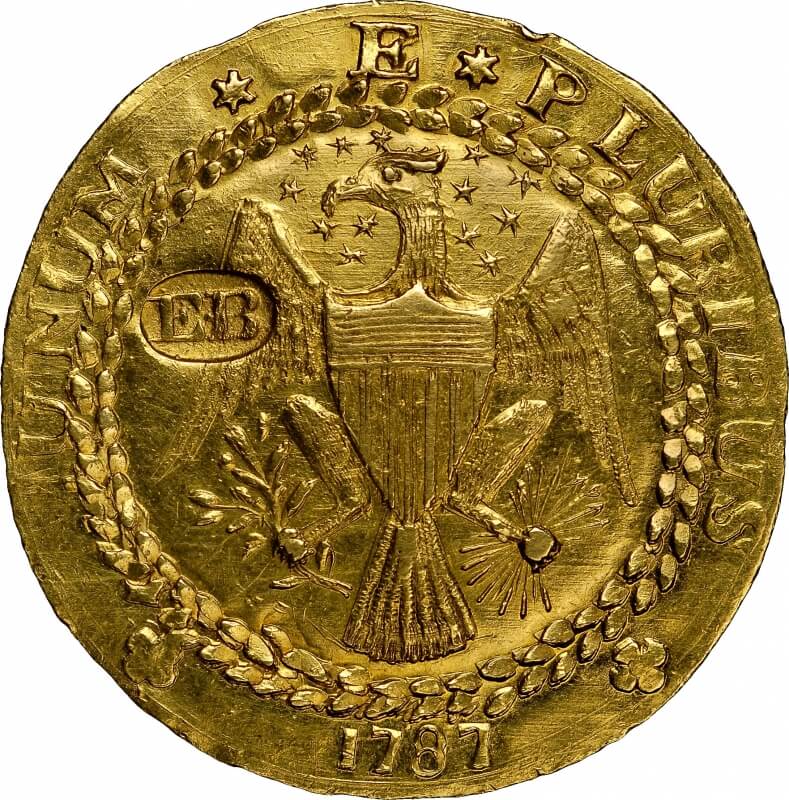Brasher Doubloon, American
Firsts Series, Bebee notes headline exhibit
The American Numismatic Association
will present a stunning Museum Showcase of numismatic treasures and rare
currency worth more than $20 million at the 2015 National Money Show, held
March 5-7 at the Oregon Convention Center in Portland, Oregon.
“The ANA Museum Showcase was created to
highlight spectacular numismatic rarities at ANA conventions,” said Douglas
Mudd, curator of the ANA’s Edward C. Rochette Money Museum. “It features
museum-quality displays of objects rarely available for public view, making
each showcase a once-in-a-lifetime opportunity to see the legendary icons of
numismatics and learn the stories behind them.”
The famed Brasher Doubloon, the first
circulating gold coin struck in the United States, is one of the featured
exhibits in the Museum Showcase. Its creator, Ephraim Brasher, was a neighbor
of George Washington while he lived in Philadelphia. The Brasher doubloon is
the first gold coin with a distinctly American design struck to the weight and
purity standard that would later be adopted for U.S. gold coins. The Brasher
Doubloon has been generously loaned to the ANA by Adam Crum and courtesy of
Monaco Rare Coins.
“The Brasher doubloon is truly a
spectacular coin – not only is it a genuine rarity with high monetary value, it
is a historical treasure-trove because of what it represents as the first gold
coin struck for the nascent United States,” Mudd said. “It is beautiful and
historically important as a record of the early design concepts discussed in
Congress for U.S. coinage as the doubloon was being struck by Ephraim Brasher
just a few blocks away.”
Other features in the Museum Showcase
include:
- The American Firsts series, which includes the
1652 Pine Tree shilling, 1776 Continental dollar, 1787 Fugio cent and the
1792 half disme, all of which represent firsts in American numismatic
history. The Pine Tree shillings were the first silver coins to be struck
in English North America, while the Continental dollar represents the
first coins struck for the United Colonies in revolt from Great Britain.
The Fugio cent is the first official coinage of the United States, and the
1792 half disme is one of the first coins struck by the United States
Mint. - The 1933 Indian Head $10 gold eagle, which is
the only gold U.S. coin of 1933 that is legal to own (apart from a single
1933 double eagle). Along with the $20, most of the 312,500 eagles minted
in 1933 were melted down when gold was demonetized by Executive Order
#6260 shortly after their release. Only about three dozen examples are known
today, and almost all are in mint state. - The Numismatic Legacy of Alexander the Great,
which explores Alexander’s vast numismatic legacy, which would continue to
his successors and later kingdoms and cities for generations. - Traditional Money of the Northwest: Potlatch
coppers, a tradition among the indigenous peoples of the Pacific Northwest
Coast. A potlatch is a gift-giving feast, often lasting for several days,
that was a means of economic exchange. The most significant of all
gifts were large sheets of shield-shaped copper decorated with a variety
of tribal crests. These objects are known collectively in English as
“coppers” or “shields.” The value of these pieces was primarily measured
in prestige, but they were also valued in terms of bride price, blankets
or slaves to name a few. - The famous Bebee collection of paper money.
Featured notes include the series of 1934 $10,000 and the series of
1914 red seal $100 Federal Reserve notes, as well as the “Watermelon
Note,” a Series 1890 $100 Treasury note that gets its nickname from the
large, bloated zeroes that appear on its back.
The Portland National Money Show
features more than 500 numismatic dealers with extensive inventories; the
Collector Exhibits area; and a wide range of educational presentations and
seminars. Show hours are 10 a.m. to 5:30 p.m. Thursday, March 5, and Friday,
March 6; and 10 a.m. to 4 p.m. Saturday, March 7. ANA members are admitted
free. Admission is free for everyone on Saturday, March 7. For more
information, go to NationalMoneyShow.com.
The American Numismatic Association is a congressionally
chartered nonprofit educational organization dedicated to encouraging people to
study and collect money and related items. The ANA helps its 25,000 members and
the public discover and explore the world of money through its vast array of
education and outreach programs, as well as its museum, library, publications,
conventions and seminars. For more information, call 719-632-2646 or go to
www.money.org.
IMMEDIATE RELEASE: Thursday, February
12, 2015
CONTACT: Jake Sherlock
Telephone: 719-482-9872
E-mail: pr@money.org
